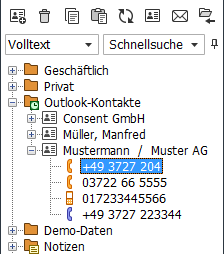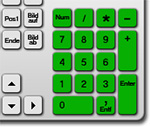Phone Control via PhoneDialog
The PhoneDialog is used for status indication and control of an assigned TAPI device (phone). If you want to control multiple TAPI devices, you can create a corresponding number of phone dialogues. More infos...
Based on Windows® TAPI interface the xtelsio CTI Client offers comfortable telephony features: Dial, Hang up, Answer, Consultation, Hold, Toggle, Transfer, Conference, Redirect.
Dialing via folder structure

A double click on a phone number / name in the folder structure initiates a call setup.
If only one phone number is put down to a record, the suitable phone icon (e.g.,
) is shown beside the name.
If there are several phone numbers to one record,
is shown before the name. Then a double click on the name lists all phone numbers.
= private phone number
= business phone number
= business fax number
Speed Dial / TAPI Monitoring
The speed-dial buttons allow quick call setup by mouse click. By the the context menu of the speed dial buttons a TAPI device can be assigned to every key whose connecting state is signalled then by LED. So you see immediately whether the other one is free or just calls up.
In conjunction with the CTI Server, a speed dial panel can also map a client group with presence status.
Permanently visible speed dial (Sidebar):
Via [Menu > Window > Sidebar] permanently visible speed dial buttons can be shown on the screen .
Dial via keyboard (prepare dial)

The function "Prepare dial" displays the standard PhoneDialog in the foreground and assigns the input focus.
The "Dial via keyboard" works as follows:
- Press hot key for "Prepare dial".
- Enter the number to be dialed.
- Press "Return" to start dialing.
Configuration: [Options > Telephony > Prepare dial]
Dialing from within other applications
The CTI Client provides functions to dial from other applications, via middle mouse button (OCR), Hotkey, TAPI connector, or through a URL link.More infos...
Terminal Server / RDP
As of CTI Client Version 3.1.009 you can connect a local CTI Client instance to a CTI Client instance in a terminal session. This is useful, for example, if:
- the CTI Client SoftPhone should run locally,
- a TAPI driver is only available locally,
- an IP telephone can only be integrated locally.
- More infos...
Outside line access code:
Via "Out" button you can set the outside line access code for external numbers. The outside line code is automatically added when dialing. The numbers are therefore always to enter without an outside line code.
In the journal, the numbers are always displayed without outside line code. If the numbers are displayed with outside line code to you, the settings for an outside line code are probably not correct.Outside line access in the Windows TAPI system:
Since the outside line access is managed by the CTI Client, NO outside line access code should be entered in the Windows system under [Control Panel > Telephone and Modem > Dialing Plans > Own Location > Edit]!
This is relevant if you execute TAPI dialing actions in other applications (via the "CTI Client TAPI Connector" or via "Assisted Telephony").Outside line access when dialing from other TAPI-enabled applications (e.g. CRM application)
If you dial from other TAPI-enabled applications, no outside line access code should be configured in these applications or under "Phone and Modem".
However, if an outside line access code is required there, then the CTI Client must be informed via the following settings that the phone number will be transferred with an outside line access code.[Options > Telephony > Advanced Settings > More Settings]:
- Dialing via Assisted Telephony includes the outside line access code
- Dialing via "CTI Client TAPI-Connector" transfers the phone number with outside line access code
FAQ / Error pictures
- FAQ1: With TAPI dialing, a 0 is removed from the phone number.
- Example: In the CTI Client you dial 005401234567, with the first 0 being the outside line access.
However, the CTI Client interprets this number as an international (Argentinian) number and removes the 0 after 0054.- Solution: You must configure the outside line access code in the CTI Client and then ensure that you always dial the numbers without an outside line access.
- FAQ2: Telephone numbers are displayed in the CTI Client with an outside line code or the 0 in front of the area code is missing.
- There is also no name resolution based on the integrated telephone books.
- Solution: Check the outside line access settings
TAPI-Functions
Basic TAPI Functions: The base-functions are supported from most TAPI devices. Dial
Click the green handset button or the "OK" button to dial the number in the appropriate field.
If your environment does not support TAPI dialing with automatic handsfree, possibly your phone is ringing first and as soon as you pickup the target subscriber is called.Hang Up
To drop call, you can click on the "red" button or the "X" button. Answer Call
This function is not supported by all TAPI drivers. If available, the "Ok" button is enabled.
Extended TAPI functions: The extended functions are only available if supported by the hardware and the TAPI driver. Functions which are generally not supported are hidden. Functions that are not available in the current conversation state are disabled (grey). Consultation
You are already in a conversation. Setup a consultation to another phone number causes that the current call is held and the other user is called. As soon as the other party accepts, you can transfer the call. Depending on the TAPI device/driver, SwapCall and/or Conference is also supported. Consultation by speed dial button: If you are already in a conversation, a click onto a speed dial button holds the current call and dials the phone number as a consultation call. Hint: You can assign hotkeys to the speed dial buttons.
Consultation by tool button: A click to button "R" pops-up a menu with the speed dial targets. The first menu entry can be used to enter a destination number by hand.
Consultation by Call-Tab: Enter a consultation number on a second call tab, and then press Enter. Hint: Via the call tab, you can also search for name.
Konferenz
Das Konferenz-Icon wird erst freigeschaltet, wenn Sie sich in einem Rückfrage-Gespräch befinden und der TAPI-Treiber Konferenz unterstützt.
- Das integrierte SIP-SoftPhone unterstützt Konferenz erst ab Version 3.1.025. Notes on configuration...
- Die integrierten VoIP-Phone-TAPI-Treiber (z.B. für Yealink oder Snom) unterstützen keine Konferenz. Hier wäre die Konferenz direkt am Telefon zu schalten.Transfer
The held one and the active user are connected with each other. You can hang up. Some telephony systems offer also call transfers in ringing state, that is you call a user by consultation and hang up, still before he picks up. The held user hears the ring tone now. You can hang up. Hold
As soon as you put a conversation on hold, the other user hears wait-music and you can call a further user (consult) or you can re-connect to the old conversation. 
Redirect incoming call or conversationA click to this tool button pops-up a menu with speed dial targets for redirect. The first menu entry can be used to enter a destination number by hand.
Redirect by drag-and-drop: Drag and drop the active call tab to the desired speed dial button.
Pickupvia speed dial key: For this function a speed dial button has to be assigned the TAPI line of the other extension. See: Speed Dial. If you click a speed dial button during incoming call the call is redirected to the own TAPI line. via Pickup button: Clicking on this tool button shows a menu with all speed dial targets for Pickup. The first menu entry can be used to enter a destination number by hand.
Redial
Ends the current call and starts the redial timer (30 sec). On timer elapsed event the number is dialed again automatically.
For configuration see: [Options > Telephony > Extended Settings > Redial]
Error Analysis
If you have a problem with the telephone control, for example your telephone does not react as wanted or the application indicates a wrong call state, then you can use the TAPI Monitor to analyse the error.
The receiver does not react anymore: Probably the TAPI Driver was wedged. Is the case run [File > Re-start Application]. If that does not help, restart your computer.

